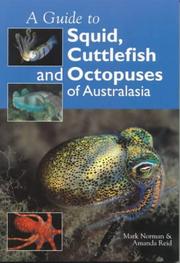| Listing 1 - 3 of 3 |
Sort by
|

ISBN: 0643101098 9786613156815 1283156814 9780643101098 9781283156813 9780643102613 0643102612 0643065776 9780643065772 Year: 2000 Publisher: Collingwood, Vic. Moorabbin, Vic. CSIRO Pub. Gould League
Abstract | Keywords | Export | Availability | Bookmark
 Loading...
Loading...Choose an application
- Reference Manager
- EndNote
- RefWorks (Direct export to RefWorks)
Provides insights into the biology and behaviour of more than 60 species - from the Giant Squid to the deadly Blue-ringed Octopus.
Cephalopoda --- Cuttlefish --- Octopuses --- Squids --- Malaiischer Archipel. --- Cephalopoda. --- Octopus. --- Squid. --- Cuttlefish. --- Australasia.
Book
Abstract | Keywords | Export | Availability | Bookmark
 Loading...
Loading...Choose an application
- Reference Manager
- EndNote
- RefWorks (Direct export to RefWorks)
Cephalopods usually have large and mobile eyes with which they constantly scan their environment. The eyes of cephalopods are single-chamber eyes which show resemblance to vertebrate eyes. However there are marked differences such as the cephalopod eye having an everted retina instead of an inverted retina found in vertebrates. Their visual system allows the cephalopods, depending on species, to discriminate objects on the basis of their shapes or sizes, images from mirror images or to learn from the observation of others. The cephalopod visual system is also polarization sensitive and controls camouflage, an extraordinary ability almost exclusive to all cephalopods; they are capable of rapidly adapting their body coloration as well as altering their body shape to any background, in almost any condition and even during self-motion. Visual scene analysis ultimately leads to motor outputs that cause an appropriate change in skin coloration or texture by acting directly on chromatophores or papillae in the skin. Mirroring these numerous functions of the visual system, large parts of the cephalopod brain are devoted to the processing of visual information. This research topic focuses on current advances in the knowledge of cephalopod vision. It is designed to facilitate merging questions, approaches and data available through the work of different researchers working on different aspects of cephalopod vision. Thus the research topic creates mutual awareness, and facilitates the growth of a field of research with a long tradition - cephalopod vision, visual perception and cognition as well as the mechanisms of camouflage. This research topic emerged from a workshop on “Vision in cephalopods” as part of the COST Action FA1301.
visual system --- cuttlefish --- visual ecology --- visually guided locomotion --- MRI --- octopus --- optic lobes --- eye development --- camouflage --- visual cognition
Book
ISBN: 3039218190 3039218182 Year: 2019 Publisher: MDPI - Multidisciplinary Digital Publishing Institute
Abstract | Keywords | Export | Availability | Bookmark
 Loading...
Loading...Choose an application
- Reference Manager
- EndNote
- RefWorks (Direct export to RefWorks)
Marine biotoxins may pose a threat to the human consumption of seafood and seafood products. The increasing global trade and higher demand for seafood products worldwide represents a challenge for food safety authorities, policy makers, food business operators, and the scientific community, in particular, researchers devoted to environmental sciences, toxicology, and analytical chemistry. In addition, due to changes in climate conditions and technological developments, new and emerging marine toxins are being detected in regions where they were previously unknown. This Special Issue highlight studies aiming to the develop detection methods for marine biotoxins for better understanding the dynamics of accumulation/elimination of marine biotoxins and their effects on marine organisms, as well as toxin exposure studies that aim to evaluate the risks associated with the consumption of contaminated seafood.
mass mortality --- marine biotoxin --- n/a --- alamethicin --- synergy --- seafood toxin --- patulin --- Paralytic shellfish toxin --- greater blue-ringed octopus --- Alexandrium catenella --- paralytic toxicity --- Ishigaki Island --- depuration --- okadaic acid --- serum biomarker --- ecotoxicological responses --- Hapalochlaena lunulata --- sydowinin A --- purification --- PSP outbreak --- southern Chile --- posterior salivary gland --- saxitoxin --- harmful algal blooms --- gliotoxin --- seafood safety --- uptake --- immunoaffinity column --- Alexandrium --- sydowinol --- chronic exposure --- environmental neurotoxin --- assimilation --- shellfish --- LC-MS --- biotransformation --- Perna viridis --- domoic acid --- fish --- algal toxin --- warming --- tetrodotoxin --- Mesodesma donacium --- combination index --- ultrahigh high performance liquid chromatography tandem mass spectrometry
| Listing 1 - 3 of 3 |
Sort by
|

 Search
Search Feedback
Feedback About UniCat
About UniCat  Help
Help News
News